In recent years, the art world has witnessed a revolutionary shift with the emergence of Non-Fungible Tokens (NFTs). These digital certificates of ownership have transformed how art is bought, sold, and appreciated. However, as this innovative technology gains momentum, concerns regarding transparency and accountability have come to the forefront. In GalleryLand, ensuring transparency in NFT transactions is paramount to maintaining trust and integrity within the art community.

The Rise of NFTs in GalleryLand
NFTs have revolutionized the art market by providing a secure and transparent way to buy, sell, and authenticate digital artworks. Unlike traditional art transactions, NFTs are recorded on blockchain ledgers, ensuring immutability and transparency. This has opened up new opportunities for artists, collectors, and investors to participate in the digital art ecosystem.
Challenges of Transparency in NFT Transactions
Despite the benefits of blockchain technology, ensuring transparency in NFT transactions poses several challenges. One major concern is the anonymity of buyers and sellers. While blockchain records are publicly accessible, identifying the parties involved in a transaction can be difficult. This lack of transparency can lead to doubts about the authenticity and provenance of NFT artworks.
Implementing Accountability Measures
To address these challenges, stakeholders in GalleryLand are implementing various accountability measures. One such measure is the use of verified platforms and marketplaces. By transacting through reputable platforms, buyers and sellers can ensure that NFT artworks meet certain standards of authenticity and transparency.
Additionally, some artists and galleries are incorporating detailed provenance records into their NFT listings. These records document the artwork’s creation process, previous ownership, and any associated intellectual property rights. By providing comprehensive provenance information, artists can enhance the transparency of their NFT artworks and build trust with potential buyers.
The Role of Smart Contracts
Smart contracts play a crucial role in ensuring transparency and accountability in NFT transactions. These self-executing contracts are programmed to automatically enforce the terms of a transaction once certain conditions are met. By utilizing smart contracts, artists and collectors can establish clear ownership rights and royalties for NFT artworks, enhancing transparency and accountability throughout the lifecycle of the artwork.
Conclusion
In GalleryLand, ensuring transparency and accountability in NFT transactions is essential for fostering trust and confidence within the art community. By leveraging blockchain technology, implementing accountability measures, and embracing smart contracts, stakeholders can address the challenges posed by NFTs and create a more transparent and sustainable art market.
FAQs
1. How can I verify the authenticity of an NFT artwork?
- To verify the authenticity of an NFT artwork, look for listings on verified platforms and marketplaces. Additionally, review the artwork’s provenance records to ensure its legitimacy.
2. Are NFT transactions anonymous?
- While blockchain records are publicly accessible, the identities of buyers and sellers are often pseudonymous. However, some platforms may require users to undergo identity verification processes.
3. What are smart contracts, and how do they enhance transparency in NFT transactions?
- Smart contracts are self-executing contracts programmed to automatically enforce the terms of a transaction. By utilizing smart contracts, stakeholders can establish clear ownership rights and royalties for NFT artworks, enhancing transparency and accountability.
4. How can artists ensure transparency in their NFT listings?
- Artists can ensure transparency in their NFT listings by providing detailed provenance records documenting the artwork’s creation process, previous ownership, and any associated intellectual property rights.
5. What measures can collectors take to protect themselves when buying NFT artworks?
- Collectors can protect themselves when buying NFT artworks by conducting thorough research, transacting through verified platforms, and reviewing the artwork’s provenance records. Additionally, consider consulting with legal experts familiar with NFT transactions to ensure compliance with relevant laws and regulations.